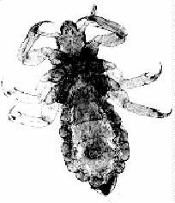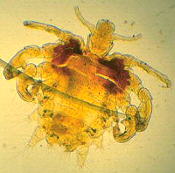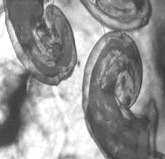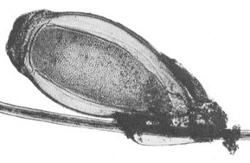
Click here for the most stunning and infomative account of lice infestation: body lice and head lice - 1999 - summer! 1) Nightmare: A True account of Resistant lice 1998
2) Lice Wars - Body Lice and Head Lice (Multi-media experience) 1999
To set the scene ...

Lice are small wingless insects, well suited to their mode of living. Three types affect man: the head louse (Pediculus capitas, shown left above), the body louse (Pediculus corporis) and the Pubic or Crab louse (Phthirius pubis, shown on the right above).
The louse's body looks squashed and flattened, enabling it to lie close to its host's skin. This is ideal for it to obtain the blood which makes up its diet. Human lice all belong to a group known as sucking lice (order Anoplura). Meal times involve three needle like structures (stylets) piercing the skin which is held back by a specially adapted tongue. This is followed by a pumping action of the throat which causes the blood to be sucked up. When not in use the stylets retract neatly into a pocket just behind the mouth. Meals are frequent and each takes a few minutes.
 Once a louse
has found a a good blood supply there is little need for it to
move, as its food resource is not going to go away. The legs of
the lice are therefore, not so much for walking, but more for
hanging in there. Their legs are inwardly curved and have well
developed "claws" for hair grasping (shown in the image
left). The claws in the pubic louse, which lives in the pubic
region are very pronounced giving rise to its alternative name of
crab louse and the more derogatory "crabs". The body
louse can live in the fibres of clothing, leaving only to feed on
blood.
Once a louse
has found a a good blood supply there is little need for it to
move, as its food resource is not going to go away. The legs of
the lice are therefore, not so much for walking, but more for
hanging in there. Their legs are inwardly curved and have well
developed "claws" for hair grasping (shown in the image
left). The claws in the pubic louse, which lives in the pubic
region are very pronounced giving rise to its alternative name of
crab louse and the more derogatory "crabs". The body
louse can live in the fibres of clothing, leaving only to feed on
blood.
 Eggs are laid singly or in
clumps and are cemented to a hair (shown in the image right), though the body
louse will also lay its eggs in clothing next to the skin. The hatching of the
mature nymph is wind driven! Air is collected through the nymph's mouth and
passes through its digestive system until the gas pressure is great enough to
eject the nymph. The hatched nymph looks more or less like a smaller version
of the adult. It undergoes three moults before reaching adulthood. The whole
life cycle can take up to five weeks.
Eggs are laid singly or in
clumps and are cemented to a hair (shown in the image right), though the body
louse will also lay its eggs in clothing next to the skin. The hatching of the
mature nymph is wind driven! Air is collected through the nymph's mouth and
passes through its digestive system until the gas pressure is great enough to
eject the nymph. The hatched nymph looks more or less like a smaller version
of the adult. It undergoes three moults before reaching adulthood. The whole
life cycle can take up to five weeks.
There are about 400 different species of sucking lice.
Lice range in size from 0.3 mm to 11 mm
Lice affect nearly all mammal species, though none is known to infect whales or bats, and none has been taken from duckbilled platypus, anteaters or armadillos.
The body louse can carry diseases like
typhus, relapsing fever and trench fever. During the Russian
revolution, it is thought that three million people died from
louse borne typhus.
Beethoven did not suffer from headlice! 582
strands of the composer's hair have been under analysis at a
laboratory in Arizona, and it has been found that despite the
plague of head lice in nineteenth century Europe, Beethoven's
locks were nit free. (from
The Times 30.5.96)
According to Dr John Maunder of the Medical Entomology centre in Cambridge, there is an increase in nit reports every autumn but not necessarily in nits. He suggest that the culprits are "carriers" who support colonies of nits without realising. These carriers don't itch and so don't treat their scalps but do infect others during the school holidays.
It is estimated that head louse
infestations are probably in the region of well over 100,000 per
year in the UK.
The body louse can carry diseases like
typhus, relapsing fever and trench fever. During the Russian
revolution, it is thought that three million people died from
louse borne typhus. Lenin is quoted as having said at that time
"Either socialism will defeat the louse, or the louse will
defeat socialism".
Nitshill in Glasgow has no lousy connections - it is thought that the "nit" in Nitshill is the Scottish word for "nut" or for Oak gall.
Comments on the article to the author Anne Bruce
Please report any Web problems
or offer general comments to the Micscape Editor,
via the contact on current Micscape Index.
Micscape is the on-line monthly
magazine of the Microscopy UK web
site at Microscopy-UK